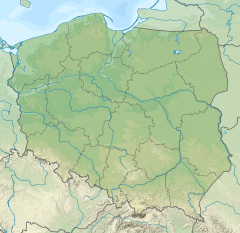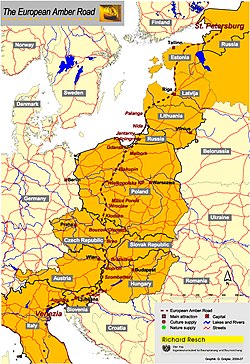| Revision as of 12:32, 9 September 2020 editDiannaa (talk | contribs)Autopatrolled, Administrators349,816 edits add quotation marks← Previous edit | Revision as of 14:38, 9 September 2020 edit undoWikirictor (talk | contribs)Extended confirmed users16,253 edits →top: textNext edit → | ||
| Line 38: | Line 38: | ||
| |notes = | |notes = | ||
| }} | }} | ||
| '''Truso''' was a ] ] town and trading center at the banks of the ] delta branch of the ], close to a bay (the modern ]), where it emptied into the shallow and ] ]. This sizeable lagoon is separated from the ] by the ] at the southern ] coast. In the 9th century, the merchant ] travelled to Truso in the service of the English King ] and |
'''Truso''' was a ] ] town and trading center at the banks of the ] delta branch of the ], close to a bay (the modern ]), where it emptied into the shallow and ] ]. This sizeable lagoon is separated from the ] by the ] at the southern ] coast. In the 9th century, the merchant ] travelled to Truso in the service of the English King ] and wrote his account of the place at a prominent location of the ], which attracted merchants from central and southern Europe, who supplied the markets in the Mediterranean and the Middle East with the highly valued commodity.<ref name=bonn>{{cite web|url= http://prussia.online/Data/Book/si/siedlungsforschung-archaeologie-geschichte-geographie-band-22/Siedlungsforschung.%20Bd.%2022%20(2004),%20OCR.pdf |title= Siedlungsforschung. Archäologie – Geschichte – Geographie 22, 2004 |date= |publisher= Siedlungsforschung Bonn |author=Klaus Fehn, Dietrich Denecke, Hans-Rudolf Egli, Eike Gringmuth-Dallmer, Franz Irsigler, Winfried Schenk |accessdate =September 8, 2020}}</ref> | ||
| The account of the voyage to the town of Truso in the land of the ''Pruzzens'' |
The account of the voyage to the town of Truso in the land of the ''Pruzzens'' around the year 890 by ] has been included in ]'s translation of ]' ''Histories''. In the words of ], "the name of the town is the earliest known historically in the Baltic Sea area".<ref name="Gimbutas">{{cite book|author1=Marija Gimbutas|author2=Alseikaitė|title=The Balts|url=https://books.google.com/books?id=-8iBAAAAMAAJ|year=1963|publisher=Praeger}}</ref> | ||
| == History == | == History == | ||
Revision as of 14:38, 9 September 2020
Early Medieval trading center at the southern Baltic Sea coast | |
| Location | Northern Poland |
|---|---|
| Region | Vistula Lagoon, Pomerania |
| Coordinates | 54°04′00″N 19°27′00″E / 54.066667°N 19.45°E / 54.066667; 19.45 |
| Area | around 20 ha |
| History | |
| Abandoned | 10th-century |
| Cultures | Baltic, Slavic, Gothic, Scandinavian |
| Site notes | |
| Excavation dates | 1897, 1945, 1980 |
| Archaeologists | Marek F. Jagodziński |
| Website | Muzeum Archeologiczno-Historyczne |
Truso was a Medieval Old Prussian town and trading center at the banks of the Nogat delta branch of the Vistula River, close to a bay (the modern Drużno lake), where it emptied into the shallow and brackish Vistula Lagoon. This sizeable lagoon is separated from the Gdańsk Bay by the Vistula Spit at the southern Baltic Sea coast. In the 9th century, the merchant Wulfstan of Hedeby travelled to Truso in the service of the English King Alfred the Great and wrote his account of the place at a prominent location of the Amber Road, which attracted merchants from central and southern Europe, who supplied the markets in the Mediterranean and the Middle East with the highly valued commodity.
The account of the voyage to the town of Truso in the land of the Pruzzens around the year 890 by Wulfstan of Hedeby has been included in Alfred the Great's translation of Orosius' Histories. In the words of Marija Gimbutas, "the name of the town is the earliest known historically in the Baltic Sea area".
History

Truso was situated in a central location upon the Eastern European trade routes, which led from Birka in Sweden via Visby on the island of Gotland towards the southern Baltic Sea shore, where in the 13th-century the Hanseatic city of Elbing (since 1945 Elbląg) was established. From there, trade continued further south to Carnuntum in the Alps along a route called the Amber Road. These ancient roads led further south-west and south-east to the Black Sea and eventually to North Africa and Central Asia. "For Old Prussia, Truso played the same role as Haithabu (Hedeby) for north-western Germany or Slavic Vineta for Pomerania", Gimbutas has observed.
East–western trade routes lead from Truso and Wiskiauten (a rival trading centre in Old Prussia, at the south-western corner of the Courish Lagoon), along the Baltic Sea to Jutland and from there up the Slien inlet to Haithabu (Hedeby), the large trading center in Jutland. This town, located close to the modern city of Schleswig in Schleswig-Holstein, was centrally located and could be reached from all four directions over land as well as from the North Sea and the Baltic Sea.
Around the year 890, Wulfstan of Hedeby embarked on a seven-day journey from Hedeby to Truso at the behest of king Alfred the Great. He names the lands and the coasts he passes as the ship was running under sail all the way. Weonodland was on his right and Langland, Laeland, Falster and Sconey on his left, all land that is subject to Denmark.
Wulfstan resumes: "Then on our left we had the land of the Burgundians, who have a king to themselves. Then, after the land of the Burgundians, we had on our left the lands that have been called from the earliest times Blekingey, and Meore, and Eowland, and Gotland, all which territory is subject to the Sweons; and Weonodland (the land of the Wends) was all the way on our right, as far as the Vistula-estuary."
The primary export resources of Truso were amber, furs and slaves, while the industries of blacksmithing and amber working provided processed goods. The beginnings of the town can be dated back to approximately the end of the 8th century, while in the second half of the 10th century, siltation slowly cut off the town from the Vistula lagoon as it began to decline and was eventually eclipsed by the ascent of Gdańsk as the local trading center.
One possible reason for this expedition was, that Alfred needed aid in his defense against the Danish and Norwegian Vikings, who had already taken over most of England. However, this reason for the journey is rather unlikely, since Truso was at the time little more than a trading center, and Alfred the Great, the West Saxon ruler, already kept in close contact with the continental Saxons and the Franks.
Archeology

First attempts at finding the exact location of the town date back to the early sixteenth century. Based on Prussian archaeological finds from 1897 and excavations which began in the 1920s, archaeologists located Truso near Elbing (since 1945 Janów Pomorski near Elbląg). Found artifacts, dating from the 7th to 12th century, were stored in the Elbing Museum, now the Elbląg Museum. In the 1980s, the Polish archaeologist Marek Jagodziński had resumed excavations and cleared a site of circa 20 hectare, in which a series of structures had burnt down around the year 1,000 AD.
The Scandinavian influence on these settlements and artefacts is particularly obvious and confirms Viking expansion of settlement activity to Courland and Livland. As early as the 8th century, the first incursions of North Germanic groups took place, which lead to the founding of the Grobin/Seeburg settlement near Liepája. Archbishop Rimbert of Bremen recorded the immigration of a group under the Sveakönig Olaf during the 9th century.
Gwyn Jones notes that at the 20 ha sized area "no true town has been found and excavated" and that the identification of the site in Elbląg with Truso is based on "finds of Norse weapons" and the presence of "a large Viking Age cemetery" nearby, According to Mateusz Bogucki "by now, there is no doubt that the settlement really is Wulfstan's Truso" The Elbląg Museum brochure: Truso- A Discovered Legend, by Marek F. Jagodziński, describes a large number of buildings found during the recent excavations, with burnt remains of posts suggesting buildings of c. 5 x 10 m and long houses of about 6 x 21 m. A thick layer of ash and numerous arrowheads suggest that the city was destroyed by pirates.
Mateusz Bogucki states in the book "Coin finds in the Viking Age Emporium Truso" (Warsaw 2007, page 83) about ...the end of Truso as a port of trade...a strong political power, probably of Piast origin...sent warriors to try to take control...destroyed the town.
References
- ^ Klaus Fehn, Dietrich Denecke, Hans-Rudolf Egli, Eike Gringmuth-Dallmer, Franz Irsigler, Winfried Schenk. "Siedlungsforschung. Archäologie – Geschichte – Geographie 22, 2004" (PDF). Siedlungsforschung Bonn. Retrieved September 8, 2020.
{{cite web}}: CS1 maint: multiple names: authors list (link) - ^ Marija Gimbutas; Alseikaitė (1963). The Balts. Praeger.
- J. M. de Navarro (1925). "Prehistoric Routes between Northern Europe and Italy Defined by the Amber Trade". The Geographical Journal. 66 (6). Jstor: 481–503. doi:10.2307/1783003. JSTOR 1783003.
- Anna J. Mukherjee. "The Qatna lion: scientific confirmation of Baltic amber in late Bronze Age Syria" (PDF). Uni Heidelberg. Retrieved September 8, 2020.
- ^ Richard 1552?-1616 Hakluyt; King of England 849-899 Alfred (25 August 2016). The Discovery of Muscovy, from the Collections of Richard Hakluyt. with the Voyages of Ohthere and Wulfstan from King Alfred's Orosius. BiblioBazaar. ISBN 978-1-361-90940-9.
{{cite book}}: CS1 maint: numeric names: authors list (link) - ^ Marek F. Jagodziński. "Truso between Weonodland and Witland". Academia. Retrieved September 8, 2020.
- ^ Bogucki, Mateusz (2004). "Viking age trade ports in Poland". Estonian Journal of Archaeology. 8 (2): 100–127.
- ^ Heiko STEUER. "Die Ostsee als Kernraum des 10. Jahrhunderts und ihre Peripherien" (PDF). Albert-Ludwigs-Universität Freiburg. Retrieved September 8, 2020.
- Jones, Gwyn. A History of the Vikings. Oxford University Press, 2001. ISBN 0-19-280134-1. Page 244.
- "Deutsch-polnische Ausgrabungen auf dem wikingerzeitlichen Seehandelsplatz von Janów Pomorski (Truso)". Albert-Ludwigs-Universität Freiburg. Retrieved September 9, 2020.
External links
- The Project Gutenberg Etext of Discovery of Muscovy - The complete texts translated to modern English
- Historia de los Gotlandeses (Guta saga)
| Norse people | |||
|---|---|---|---|
| History |  | ||
| Expansion |
| ||
| Paganism and mythology | |||
| Cosmology | |||
| Rituals and worship | |||
| Society | |||
| Events | |||
| Sources | |||
| Settlements | |||